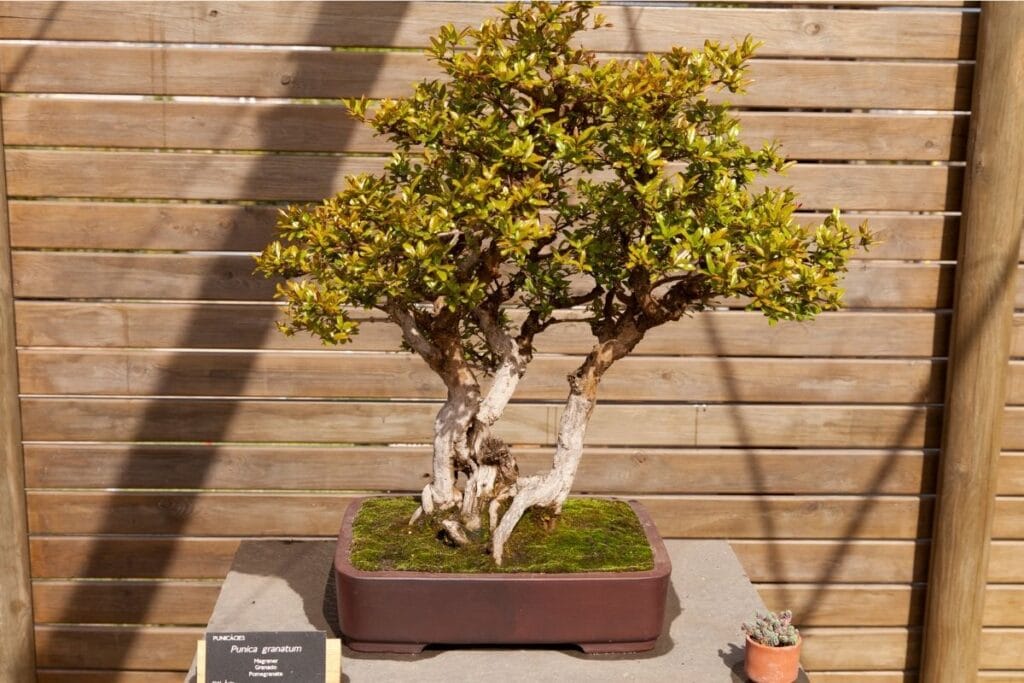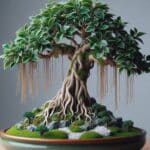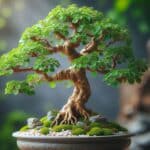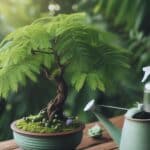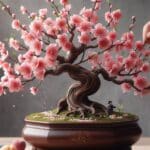You may adore pomegranate trees, or Punica granatum, for their delicious fruits. However, did you know that you can also grow pomegranate bonsai trees?
There are many different varieties of pomegranate trees you can grow, each of which is beautiful in its own right and offers unique colors, shapes, and sizes of both fruit, flowers, and trunks.
Native to the Middle East and areas of Southeast Asia, the pomegranate tree is now found in many different countries all over the world. It is popular among bonsai growers for its deciduous broadleaf beauty and eye-catching bark, as well as for the ancient, gnarled appearance of its roots and trunk. Additionally, pomegranate trees produce showy trumpet shaped red flowers that bloom in the early spring, adding to their overall appeal.
If you’re thinking about growing a pomegranate plant as a fruit bonsai tree, you’ve made a wonderful choice. Here are some tips to help you get started!
Interesting Facts about Pomegranate Bonsai Tree
| Height | 24” |
| Width | 4-6” |
| Sunlight | Full to partial sunlight |
| Flowering Time Length | ~3 months |
| Lifespan | 200+ years |
| Scientific Name | Punica granatum |
Growing Pomegranate Bonsai Tree from Seed or by Propagation
Pomegranate bonsai trees are easy to cultivate from seed. To do this, rinse the pomegranate seeds, remove the pulpy coating by rubbing them with a paper towel, and then allow them to dry for a few days. Plant your seeds in seed starting soil and cover with plastic to increase humidity. Keep the soil moist until the seeds germinate.
You can also propagate this tree through practices such as air layering, division, and by hardwood cuttings, but it’s admittedly more difficult and therefore less common.
How to Care for Pomegranate Bonsai Tree
Sunlight
Pomegranate bonsai trees can be grown indoors year-round, but if you are lucky enough to enjoy a Mediterranean climate where you live, you can feel free to grow these trees outside, too. They prefer warm, sunny locations but may need a bit of shade during their winter dormancy.
The ideal temperature for healthy pomegranate trees will be above 41 degrees Fahrenheit. While the tree is surprisingly hardy and can handle colder temperatures, this is not ideal and can cause stunted growth or dieback.
Watering
Water your bonsai pomegranate tree regularly to keep the soil moist – but not overly saturated. You can reduce watering during the winter months. Most growers find it helpful to simply mist the tree on a weekly basis during the cooler, albeit drier, winter months.
Excellent air circulation is vital for pomegranate bonsai trees. If you don’t provide adequate air circulation, it doesn’t matter how carefully you water because mold will still appear. If you notice mold or signs of root rot regardless, you can use a fungicide to stop the spread while you get your circulation under control.
Fertilizing
Every other week after new growth appears in the growing season, you should fertilize your bonsai tree. You can use a solid organic fertilizer that is designed specifically for bonsai trees or you can use an all-purpose plant food. Just dilute it at half strength.
In the middle of the spring, you may want to follow up with an additional feeding. Do not fertilize at all during the three months after you have reported the plant.
Potting and Repotting
More often than not, you will find that your bonsai pomegranate tree blooms more vigorously when the roots are container-bound. This unique characteristic means that you should only repot your plant once every three to four years before the leaf buds open. Do this toward the end of winter and repot your tree in a mixture that contains high amounts of lime and sand.
Pruning Pomegranate Bonsai Tree
You can prune your pomegranate tree by regularly pinching each first or third leaf. This should increase the foliage of the plant. Otherwise, let young shoots mature and become longer before you cut them back to the desired length. Additionally, pay attention to the development of flower buds on the branches.
You should avoid wiring dwarf pomegranate bonsai trees, as this can cause die-back. You can wire larger varieties but make sure you remove the wiring in a timely fashion so that scars do not appear.
Pests and Diseases
The most common pests that target pomegranate bonsai trees are whiteflies, pomegranate butterfly caterpillars, and aphids. Whiteflies are especially common with indoor-grown trees but can be controlled by spritzing the pests with water. They are generally found beneath the leaves. They can also be prevented by providing adequate ventilation.
Where to Buy Pomegranate Bonsai Tree
You can buy pomegranate bonsai trees from just about any kind of shop that specializes in bonsai plants. Choose one that is medium to large so that it will produce larger fruits – you can also use a dwarf variety, which won’t need to be wired. When buying your plant, make sure you select one with a thick trunk so that it will remain growing strong and vigorous once you put it in your bonsai container.
FAQs
Can you overwater a pomegranate tree?
Yes, you can overwater a pomegranate tree, including bonsai varieties. Overwatering can lead to root rot and other fungal diseases, causing stress to the plant and resulting in yellowing leaves, wilting, or overall decline. It’s essential to allow the soil to dry out slightly between waterings and ensure proper drainage to prevent waterlogged conditions.
Can you eat bonsai pomegranate?
Yes, you can eat the fruit of a bonsai pomegranate tree, just like you would with a standard-sized pomegranate tree. Bonsai pomegranate varieties produce small but edible fruits that can be harvested and enjoyed when ripe.
Is pomegranate bonsai indoor or outdoor?
Pomegranate bonsai trees can be grown both indoors and outdoors, depending on the climate and growing conditions. In regions with mild winters, they can be grown outdoors year-round, while in colder climates, they can be kept indoors during the winter months and moved outdoors during the warmer seasons.
Why are my pomegranate bonsai leaves turning yellow?
Yellowing leaves on a pomegranate bonsai can indicate various issues, including overwatering, underwatering, nutrient deficiencies, pests, diseases, or environmental stressors. Assessing factors such as watering practices, soil condition, light levels, and pest infestations can help determine the cause of yellowing leaves and appropriate corrective actions.
Check more flowering bonsai plants and other types of bonsai you can grow.
*image edu1971/depositphotos

